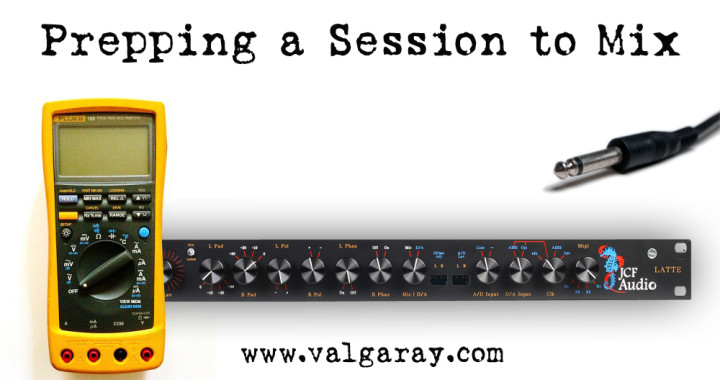Prepping a Session to Mix – Part I

Mixing a track is an invaluable engineering skill and it takes thousands of hours to develop the proper skills and ear training to get a handle on it. We’ll certainly get to my method of mixing in future blog posts, but equally important to the mix itself is the work done in preparation for mixing. The audio must be clean with no pops or added noise, all the editing should be out of the way so there’s no worrying about missing crossfades or notes out of tune or out of time, and the session should be set up in such a way that makes the final mixing process as simple as possible. The blog post within is a discourse on how I prepare a session to mix.
The easiest sessions for me to mix are the ones that I’ve tracked myself, as my workflow through the tracking process is implemented with the final mix in mind and the session is already set up the way I like it. But for the purpose of this blog, we’ll use an instance where I’m receiving a client’s recording in the form of stems. That way we can cover all the bases.
I begin by importing the stems along with the client’s rough mix into my mixing template Pro Tools session that has all of my auxiliary channels (i.e. reverbs, delays, drum buss, etc.). I put all of the stems on mono audio tracks so that I can balance the levels of stereo information. The left and right mics on overheads and high and low mics on piano, for instance, are usually not even. I select “all” in the group window so I can move all of the tracks together and everything stays in relative place.
If the tune was tracked to a click, I set the tempo and place the downbeat of the first bar at the top of bar 1, usually with two bars of space beforehand so that the grid begins with bar -1. This space at the front isn’t crucial for the mixing process, but I use two bars as a rule of thumb so if the song has a pickup, you still get a full bar of count in before the bar with the pickup. I make sure the drums, as well as the track as a whole, are lined up with the grid. Once everything’s in place, I listen to the client’s rough mix from start to finish, putting markers in place along the way to dictate the structure of the song (i.e. Intro, Ver 1, Pre Chr 1, Chr 1, Reintro, etc.). I also put in the memory locations a MIX & a MIX PIP. Incase you’re wondering what a MIX PIP is, it’s the usual mix length and I ad a16th note distance on the grid in front of the intro with a tone that makes a beep so that all the mix’s have this and different mixes can be lined up exactly if need be.
Now that the stems are imported and the song is lined up with the grid, I begin to organize the session by color-coding instruments, putting them in order, setting approximate levels and proper panning, adding plugins and sends, creating groups to link corresponding tracks (i.e. drums, kick in/out, snare top/bottom, bass di/amp, strings, harmonies, vocals), and setting outputs for each track. I utilize 32 D/A outs from Pro Tools, 1-16 through an Apogee DA-16X and 17-32 through an AVID HD I/O, that go to 2 Roll Music RMS216 Folcrom Passive Summing Devices where the 32 channels get summed to two channels and go through Josh Florian LEVR transformer line amps as a gain stage for the level reduction created by the passive summing device, then the 2 channels go to my mastering ProTools HD Native system.
Below is a chart that documents my default Pro Tools pre-mix setup. You’ll notice that the whole mix is set up to be mixed in the box, but as I come across tracks that will benefit from outboard processing (such as kick, snare, acoustic guitar, lead vocal, etc.), I pull the plugins and patch in the gear.
All of the inserts that I put on tracks have default settings that are zeroed out. The compressors need dialed in so that they’re hitting at the right amount (usually around -3 to -5 dB) and all of the EMT 140 & ALTIVERB sends set around -22.4 dB. This is just a starting point, but it’s a great place to begin a mix.


